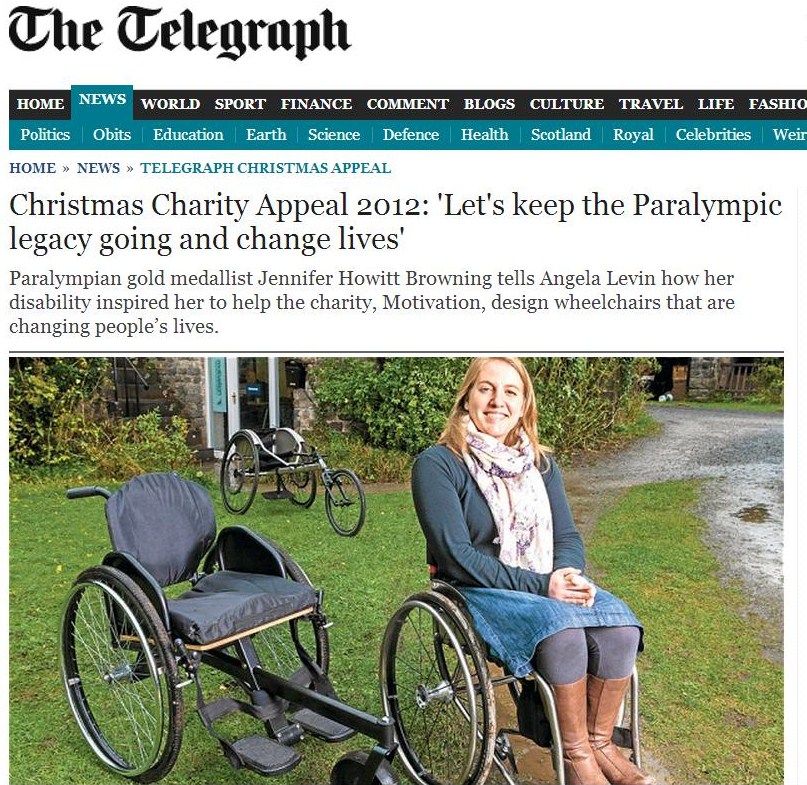Richard from the Telegraph: Well Alex, this feels like my X-factor moment…
Alex: (about to fall off her chair) oooh, um, ok…?
Richard: We’d like Motivation to be one of our charities for our 2012 Christmas appeal!
Alex: (squeals incoherently)
And so went a rather wonderful phone call last November, when I was working at the disability charity Motivation.

Our Telegraph Appeal ‘journey’ had started back in late August, when we submitted our application. In mid October we were shortlisted and invited to the Telegraph’s offices to meet deputy editor Richard Preston and some of his colleagues. We got the X-factor call in early November and the appeal launched at the end of the month. It finished in late January – by which time we’d had eight stories published, added hundreds of new contacts to our supporter database and received a large cheque (literally) to the tune of over £200,000. Not bad!
I’m sure that the Paralympics, the surprise hit of summer 2012, played a big part in our being chosen. As a disability charity involved in wheelchair sports, Motivation was certainly ‘of the moment’. But I like to think that our application had a hand in it too…
So today I’m putting together some tips for applying to newspaper appeals in the hope that comms / fundraising folk might find them useful. My suggestions are based on my experiences with the Telegraph – but I imagine they’re relevant for the other broadsheets’ appeals too.
1. Keep it brief
You’re up against lots of other charities, so you want to keep your application powerful yet pithy. Ours consisted of:
– a short covering email introducing the charity and giving a taster of story ideas
– a two-page application in a simple Word document, containing short paragraphs summarising story ideas
– one page of pics related to the stories we’d included in the application. I felt it was important to include images, not just because everyone loves a good pic but because they showed that we had great quality shots up our sleeves should the Telegraph need to draw on them (which they later did).
2. Go straight to your stories (and stats)
There’s no need for a lengthy description of what your charity does. A couple of lines will do – there’s always more detail to be found on your website.
Instead, jump straight into what the journalists racing through the piles of applications are really interested in: your stories. These should be emotive, compelling and varied, focusing on a particular person* or group of people that your charity has supported. Eight to ten story summaries should be plenty. Include some good-quality statistics to lend context and credibility to your stories. For example, ‘Like 90% of disabled children in Africa, eight-year-old Benjamin isn’t going to school today…’
*Be sure to double-check your beneficiary is happy to have their story shared in the media before you include them in your application. It’s one thing to feature on your website – it’s another to appear in the national press!

3. Look for potential stars among your staff
When you’re coming up with subjects for your stories, consider the very people you work with. Is there an inspirational former beneficiary among your colleagues? Does your chief exec have a visionary story to share? One major benefit of employees as interviewees is that they’ll be right on message (well, hopefully!). Two of our best appeal stories were about Motivation staff: co-founder David Constantine and programme manager Jen Howitt Browning, a gold medal winning Paralympian.
4. International charities should think regionally
If you work internationally, of course you can mention that you’re supporting communities from Papua New Guinea to Peru to Pakistan (etc). But does the paper have writers there? If not, it’s unlikely they’ll fork out to fly them to your projects. They’re working with limited budgets just like we are. So – and I write with hindsight – think about clustering your stories regionally. A Southeast Asia correspondent could easily pop between projects in Vietnam, Cambodia and Laos, for example. The Telegraph’s Mike Pflanz is based in Nairobi; he visited Motivation projects in nearby Uganda and Tanzania.

5. Add a dash of celebrity
If you’ve got a celeb supporter or two, they’re definitely worth a mention somewhere in your application or covering note. Every year the Telegraph runs a story featuring three celebrities endorsing the three appeal charities – we had Michael Palin writing on our behalf (lucky us). If you haven’t had much luck with celebrities in the past, the excellent CharityComms has just published a best practice guide called ‘Harnessing the talent: working with celebrities’ – might be worth a look.
More newspaper appeal tips to follow soon in part two – what to do if you’re shortlisted (after you’ve treated yourself to a celebratory slice of cake, of course).
